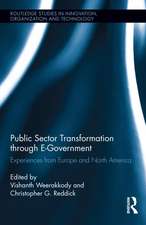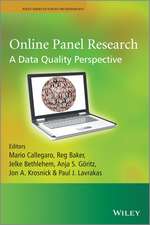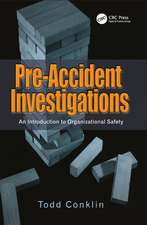The Palgrave Handbook of Survey Research
Editat de David L. Vannette, Jon A. Krosnicken Limba Engleză Hardback – 22 ian 2018
Chapter 23 of thisbook is open access under a CC BY 4.0 license at link.springer.com.
| Toate formatele și edițiile | Preț | Express |
|---|---|---|
| Paperback (1) | 1399.24 lei 6-8 săpt. | |
| Springer International Publishing – 4 iun 2019 | 1399.24 lei 6-8 săpt. | |
| Hardback (1) | 1405.72 lei 6-8 săpt. | |
| Springer International Publishing – 22 ian 2018 | 1405.72 lei 6-8 săpt. |
Preț: 1405.72 lei
Preț vechi: 1714.29 lei
-18% Nou
Puncte Express: 2109
Preț estimativ în valută:
268.98€ • 280.84$ • 222.62£
268.98€ • 280.84$ • 222.62£
Carte tipărită la comandă
Livrare economică 04-18 aprilie
Preluare comenzi: 021 569.72.76
Specificații
ISBN-13: 9783319543949
ISBN-10: 3319543946
Pagini: 580
Ilustrații: XXIV, 676 p. 10 illus.
Dimensiuni: 155 x 235 x 47 mm
Greutate: 1.15 kg
Ediția:1st ed. 2018
Editura: Springer International Publishing
Colecția Palgrave Macmillan
Locul publicării:Cham, Switzerland
ISBN-10: 3319543946
Pagini: 580
Ilustrații: XXIV, 676 p. 10 illus.
Dimensiuni: 155 x 235 x 47 mm
Greutate: 1.15 kg
Ediția:1st ed. 2018
Editura: Springer International Publishing
Colecția Palgrave Macmillan
Locul publicării:Cham, Switzerland
Cuprins
OVERVIEW. - INTRODUCTION.- SECTION 1: CONVENTIONAL SURVEY RESEARCH.- Assessing the Accuracy of Survey Research; Jon A. Krosnick.- The Importance of Probability-based Sampling Methods for Drawing Valid Inferences; Gary Langer.- Sampling for Single and Multi-Mode Surveys using Address-based Sampling – Colm O’Muircheartaigh.- Evidence About the Accuracy of Surveys in the Face of Delining Response Rates; Scott Keeter.- Sampling to Minimize Nonresponse Bias; J. Michael Brick.- Cross-national Issues in Response Rates; Vasja Vehovar & Koen Beullens.- Choosing a Mode of Survey Data Collection – Roger Tourangeau; Mixed-Mode and Mixed-Device Surveys; Edith de Leeuw & Vera Toepoel.- The Use and Effects of Incentives in Surveys; Eleanor Singer.- Methods for Determining Who Lives in a Household; Kathleen T. Ashenfelter.- Harmonization for Cross-National Comparative Social Survey Research: A Case Study Using the "Private Household” Variable; Jürgen Hoffmeyer-Zlotnik & Uwe Warner.- Answering for Someone Else: Proxy Reports in Survey Research; Curtiss Cobb.- Improving Question Design to Maximize Reliability and Validity; Jon A. Krosnick.- Cognitive Interviewing in Survey Design: State of the Science and Future Directions; Gordon Willis.- Survey Interviewing: Departures from the Script; Nora Cate Schaeffer.- How to Improve Coding for Open-Ended Survey Data: Lessons from the ANES; Arthur Lupia.- Applying Human Language Technology in Survey Research; Mark Liberman.- Maintaining Respondent Trust and Protecting their Data; Roger Tourangeau.- Tackling Panel Attrition; Peter Lynn.- Respondent Attrition vs. Data Attrition and Their Reduction; Randall J. Olsen.- Best Practices for Creating Survey Weights; Matthew DeBell.- SECTION 2: OPPORTUNITIES TO EXPAND DATA COLLECTION.- New Kinds of Survey Measurements; Carli Lessof & Patrick Sturgis.- The Role of Surveys in the Era of “Big Data”; Mario Callegaro & Yongwei Yang.- Getting the Most out of Paradata; Frauke Kreuter.- Open Probability-based Panel Infrastructures; Marcel Das, Arie Kapteyn, & Michael Bosnjak.- Collecting Interviewer Observations to Augment Survey Data; Brady T. West.- “Just one more thing” – Using Leave-behind Measurement Supplements to Augment Survey Data Collection; Michael W. Link.- Ecological Momentary Assessment in Survey Research; Arthur A. Stone.- Biomarkers in Representative Population Surveys; David Weir.- Measuring Past Events Using Calendar Aids; Robert Belli.- Collecting Social Network Data; Tobias Stark.- SECTION 3: LINKING SURVEY DATA WITH EXTERNAL SOURCES.- Methods of Linking Survey Data to Official Records; Joseph W. Sakshaug.- Linking Individual-level Survey Data to Consumer File Records; Josh Pasek.- Linking Survey Data to Administrative Records in a Comparative Survey Context; Annelies Blom & Julie Korbmacher.- Linking Survey Data with the Catalist Commercial Database; Bob Blaemire.- Challenges and Opportunities in Collecting Election Administration Data; Michael P. McDonald.- Challenges with Validating Survey Data; Matthew K. Berent.- The Promise of Collaborative Data-sharing Across Research Sectors; Robert Groves.- SECTION 4: IMPROVING RESEARCH TRANSPARENCY AND DATA DISSEMINATION.- The Importance of Data Curation; Steven Ruggles.- Improving the Usability of Survey Project Websites; David L. Vannette.- The Role of Transparency in Maintaining the Legitimacy and Credibility of Survey Research; Arthur Lupia.- Evidence-based Survey Operations: Choosing and Mixing Modes; Michael Bosnjak.- Best Practices for Survey Research; David L. Vannette.- SECTION 5: DETAILED CHAPTERS.- Reasons for Optimism About Survey Research; Jon A. Krosnick.- Probability vs. Non-probability Methods; Gary Langer.- Address-based and List-based Sampling; Colm O’Muircheartaigh.- The Impact of Survey Nonresponse on Survey Accuracy; Scott Keeter.- Optimizing Response Rates; Michael Brick.- Data Collection Mode; Roger Tourangeau.- Survey Incentives; Eleanor Singer.- Building Household Rosters Sensibly; Kathy Ashenfelter.- Proxy Reporting; Curtiss Cobb.- Questionniare Design; Jon A. Krosnick.- Cognitive Evaluation of Survey Instruments; Gordon Willis.- Interviewer Deviations from Scripts – Nora Cate Schaeffer.- Coding Open Responses; Arthur Lupia.- What HLT Can Do for You (and vice versa); Mark Liberman.- Confidentiality, Privacy, and Anonymity; Roger Tourangeau.- Panel Attrition; Randall Olsen.- Computation of Survey Weights; Matthew DeBell.- Paradata; Frauke Kreuter; Interviewer observations; Brady West.- Leave-behind measurement supplements; Michael Link.- Experience sampling; Arthur Stone.- Biomarkers; David Weir.- Specialized tools for measuring past events; Robert Belli.- Linking survey data to official government records; Joseph Sakshaug.- Linking Knowledge Networks web panel data with external data; Josh Pasek.- History and promise and blending survey data with government records on turnout; Michael P. McDonald.- Improving information quality and availability through interactions between government and academic, and industry survey research sectors; Robert Groves.- Meta data and preservation; Steven Ruggles.- Usability of survey project websites; David L. Vannette.- Research Transparency and the Credibility of Survey-Based Social Science; Arthur Lupia.-
Notă biografică
David L. Vannette is Principal Research Scientist for Qualtrics, an industry-leading provider of Online Survey Software, and a Ph.D. Candidate in the Department of Communication, Stanford University, USA. His research focuses on developing and exploring best practices in survey methodology and understanding the measurement and effects of exposure to research results published in the news media.
Jon A. Krosnick is the Frederic O. Glover Professor in Humanities and Social Sciences, Professor of Communication, Political Science, and (by courtesy) Psychology, Stanford University, USA. Winner of the American Association for Public Opinion Research’s Lifetime Achievement Award, his research focuses on attitude formation, change, and effects, on the psychology of political behaviour, and on survey research methods.
Jon A. Krosnick is the Frederic O. Glover Professor in Humanities and Social Sciences, Professor of Communication, Political Science, and (by courtesy) Psychology, Stanford University, USA. Winner of the American Association for Public Opinion Research’s Lifetime Achievement Award, his research focuses on attitude formation, change, and effects, on the psychology of political behaviour, and on survey research methods.
Textul de pe ultima copertă
This handbook is a comprehensive reference guide for researchers, funding agencies and organizations engaged in survey research. Drawing on research from a world-class team of experts, this collection addresses the challenges facing survey-based data collection today as well as the potential opportunities presented by new approaches to survey research, including in the development of policy. It examines innovations in survey methodology and how survey scholars and practitioners should think about survey data in the context of the explosion of new digital sources of data. The Handbook is divided into four key sections: the challenges faced in conventional survey research; opportunities to expand data collection; methods of linking survey data with external sources; and, improving research transparency and data dissemination, with a focus on data curation, evaluating the usability of survey project websites, and the credibility of survey-based social science.
Chapter 23 ofthis book is open access under a CC BY 4.0 license at link.springer.com.
Caracteristici
Offers a fully up to date and comprehensive examination of recent advancements in survey research Includes sections tackling best practice in survey research and highly actionable approaches recommended by the leading scholars in several highly topical areas Covers topics like collecting biomarkers, interviewer deviations from scripts, linking survey data with other types of data, and paradata












